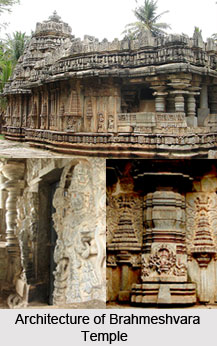 Architecture of Brahmeshvara Temple portrays the Hoysala art in South India in the medieval age. The derivation of the Hoysala art and sculpture is a matter of much interesting speculation and controversy. Illustrious dynasties like Chalukyan art, Kakatiya art and Vijaynagar art, the Seunas, the Hoysalas too assert their descent from Yadu Vangsha or the Lunar Dynasty and call themselves the Yadavas. The conventional titles like, "Yadavanarayana", "Yadavakutambrad-yumani" and "Dvaravatipura-varadhisvara" are widespread to both the Seunas and the Hoysalas dynasties of South India.
Architecture of Brahmeshvara Temple portrays the Hoysala art in South India in the medieval age. The derivation of the Hoysala art and sculpture is a matter of much interesting speculation and controversy. Illustrious dynasties like Chalukyan art, Kakatiya art and Vijaynagar art, the Seunas, the Hoysalas too assert their descent from Yadu Vangsha or the Lunar Dynasty and call themselves the Yadavas. The conventional titles like, "Yadavanarayana", "Yadavakutambrad-yumani" and "Dvaravatipura-varadhisvara" are widespread to both the Seunas and the Hoysalas dynasties of South India.
Architecture of Brahmeshvara Temple is a fine specimen of 12th century medieval art form- Hoysala architecture. Brahmeshvara Temple is located in the town of Kikkeri of Mandya district in Karnataka.
Origination of Brahmeshvara Temple
Brahmeshvara Temple was built in 1171 AD by a wealthy lady called Bommare Nayakiti during the rule of Hoysala King Narasimha I. Brahmeshvara Temple is a protected monument under the Karnataka State Division of the Archaeological Survey of India.
Design of Brahmeshvara Temple
The design of Brahmeshvara Temple is unique. The interior of Brahmeshvara Temple has been widened beyond its base by making the outer walls of Brahmeshvara Temple bulge out in a convex shape.
Walls of Brahmeshvara Temple
The walls of Brahmeshvara Temple have a unique form of art and architecture. This is an ekakuta (single shrine) construction. There is a four feet tall image of the Hindu god Shiva in one of the niches of the navaranga (hall). The madanika figures (also called Salabhanjika, refers to the sculpture of a woman, displaying stylized feminine features) carved on the capitals of the pillars of the hall are works of fine art.
Architecture around Brahmeshvara Temple
The vimana (shrine that contains the cella) has a well executed, highly decorative and intact tower (sikhara). The vestibule (called antechamber or antarala) which connects the cella to the hall has a sukhanasi (called "nose") which is actually a low protrusion of the tower over the shrine, built over the vestibule.
Tower of Brahmeshvara Temple
The standard features in a Hoysala temple are the large domed roof over the tower, which is also the largest sculptural piece in a Hoysala temple (called the "helmet" or amalaka) and whose shape usually follows that of the shrine (square or star shape); the kalasa on top of it (the decorative water-pot at the apex of the dome); and the Hoysala crest (emblem of the Hoysala warrior stabbing a lion) is over the sukhanasi.
Features of Brahmeshvara Temple
The decorative features of Brahmeshvara Temple can be said to belong to the "old kind" prevalent even before the Hoysala times. In this type of decoration, below the superstructure (tower), eaves that projects about half a meter runs all around the temple. Below the eaves are decorative miniature towers (the aedicula) on pilasters. The large wall images of deities and their attendants are placed below these decorative towers. Below these images is the base of the wall which comprises five different horizontal mouldings, one of which is a row of blocks











